Legio XVIII
Legio XVIII: one of the Roman legions. Its surname is not known, but may have been Gallica or Germanica.
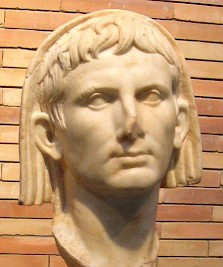
Due to the fact that they were destroyed in the battle in the Teutoburg Forest in September 9, the history of the legions XVII, XVIII and XIX is not well understood. One eighteenth legion fought with a governor named Gaius Cornelius Lentulus Spinther in Cilicia in 56-53. It is not likely that this unit is identical to the later eighteenth legion, but it cannot be excluded either.
During the civil war of 49-48, both Julius Caesar and Pompey the Great employed legions with these numbers, but we do not know what became of them, although it is plausible that Pompey's eighteenth was identical to Cornelius Lentulus Spinther's. It has been argued that the Caesarian legions, commanded by Curio, were destroyed in Africa, but this is entirely hypothetical.
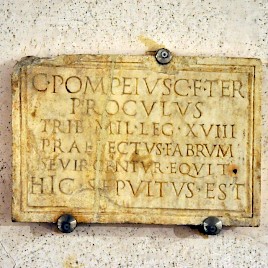
It is more probable that the Eighteenth was founded in 41 or 40 BCE, after the battle of Philippi (where Caesar's murderers Brutus and Cassius were defeated). Its founder must have been Caesar's heir Octavian, who needed new units to put an end to Sextus Pompeius' occupation of Sicily, which put the grain supply of Rome into peril. The first generation of soldiers may have consisted of veterans of the army of Brutus and Cassius; inscriptions suggests that other recruits came from northern Italy.
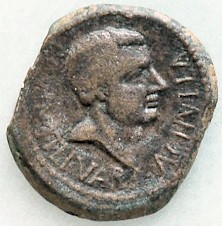
When Pompeius was defeated, Octavian and his fellow-triumvir Mark Antony fell out with each other and started a war, which culminated in the naval battle off Actium (31), where Octavian defeated his opponent and won the supremacy in the Mediterranean world. From now on, he was known as the emperor Augustus.
The possibility that the eighteenth legion is identical to the eighteenth legion Lybica of Mark Antony, cannot be excluded, but is less likely than the theory that this unit was founded by Octavian.
In 30 or 14 BCE, veterans were settled in the Veneto, which suggests that the recruits were from Gallia Cisalpina.
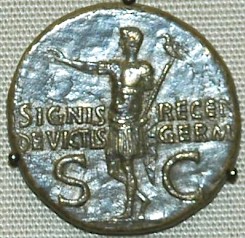
Whatever its origins - Lentulian, Pompeian, Caesarian, Octavian, Antonian - the Eighteenth was at some stage (c.15 BCE?) sent to the Rhine, together with XVI Gallica and the seventeenth legion. It is possible, but again hypothetical, that the Eighteenth had been stationed in Aquitania between the battle off Actium and the transfer.
In Germania, the soldiers part in the campaigns in Germania of Augustus' generals Drusus (13-9) and Tiberius (8 BCE and 4-5 CE). In those years, the eighteenth legion was probably based at Xanten or Oberaden/Haltern. In 5, the conquest was completed and Augustus sent Publius Quinctilius Varus to rule the area as a governor, impose tribute and establish civil rule.
In 6 CE, Tiberius was to lead at least eight legions (VIII Augusta from Pannonia, XV Apollinaris and XX Valeria Victrix from Illyricum, XXI Rapax from Raetia, XIII Gemina, XIV Gemina and XVI Gallica from Germania Superior and an unknown unit) against king Maroboduus of the Marcomanni in Czechia; at the same time, I Germanica, V Alaudae, XVII, XVIII and XIX were to move against Czechia as well, attacking it along the Elbe. It was to be the most grandiose operation that was ever conducted by a Roman army, but a rebellion in Pannonia obstructed its execution.
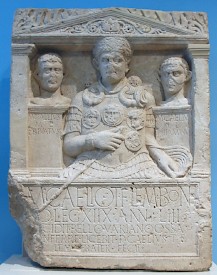
It took three years to suppress the revolt. In these years, the Eighteenth was still with Varus. In September 9, however, the Cheruscan leader Arminius, one of Rome's most loyal allies, turned himself against the governor. When reports arrived that a western tribe had revolted, Varus, unaware of Arminius' treason, followed his advise to return to the Rhine. His army was trapped in the neighborhood of Osnabrück. The seventeenth, eighteenth and nineteenth legions were completely destroyed. The three eagle standards were recovered by during the reigns of Tiberius and Caligula.
The picture shows the cenotaph of Marcus Caelius, a centurio of the eighteenth legion whose bones were never recovered, and two of the slaves he had freed (and were probably with him during the disaster in the Teutoburg Forest). The monument can be seen in the museum at Xanten. The inscription (CIL 13.8648) is as follows:
|
I Ordinis LEGionis XIIX ANNorvm LIIIS OCCIDIT BELLO VARIANO OSSA INFERRE LICEBIT Pvblivs CAELIVS Titi Filivs LEMonia tribv FRATER FECIT (more...) |
|
Bologna, first centurion of the eighteenth legion. 53½ years old. He fell in the Varian War. His bones may be interred here. Publius Caelius, son of Titus, of the Lemonian district, his brother, erected (this monument). |
The legionary emblem of legion XVIII is not known.
Literature
- R. Wiegels, "Legiones XVII, XVIII, XIX", in: Yann Le Bohec, Les légions de Rome sous le Haut-Empire (2000 Lyon) 75-8